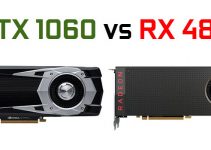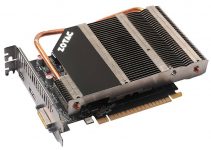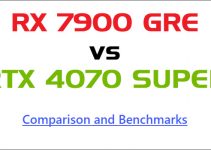Radeon RX 7600 is the third graphics card launched in the RX 7000 series from AMD after the Radeon RX 7900 XTX and RX 7900 XT. Unlike its bigger brothers which are high-end and flagship cards for 4K gaming, the RX 7600 is a mainstream card targeted for 1080p gaming. The card is said to be an upgrade to the older RX 6600 XT or RX 6650 XT cards that are based on the RDNA 2 architecture. RX 7600 competes with its older generation siblings RX 6600 XT / RX 6650 XT and RTX 3060 (12GB) from Nvidia. So, if want to know how it fairs against its competitors, please go through the comparison below.
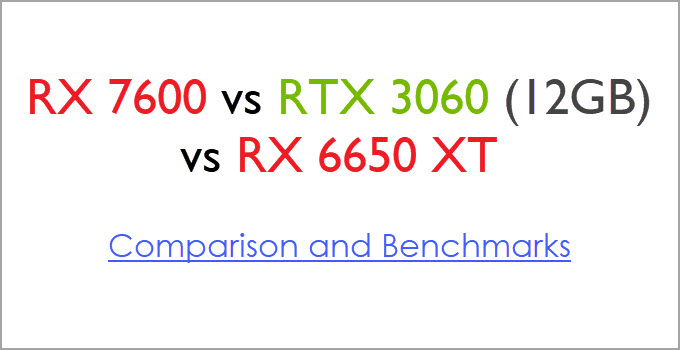
RX 7600 vs RTX 3060 (12GB) vs RX 6650 XT Comparison
Below is the comparison between RX 7600, RTX 3060 (12GB), and RX 6650 XT graphics cards based on their specifications, performance, pricing, power consumption, and features.
GPU Architecture
RX 7600 is built on the RDNA 3 GPU architecture and uses Navi 33 XL GPU. Unlike its bigger brothers RX 7900 XTX and RX 7900 XT which use chiplet GPU design having GCD (Graphics Compute Die) and MCD (Memory Cache Die) with GCD being manufactured on a 5nm process, RX 7600 uses a single chip monolith design and is built on 6nm manufacturing process. It comes with 2048 Stream Processors, 32 Ray Accelerators, and 64 AI Accelerators. On the other hand, RX 6650 is built on the relatively older RDNA GPU 2 GPU architecture on a 7nm manufacturing process. It uses Navi 23 XT GPU and comes with 2048 Stream Processors and 32 Ray Accelerators. RTX 3060 from Nvidia is built on the Ampere GPU architecture on an 8nm fabrication process. It uses GA106 GPU chip and comes with 3584 CUDA Cores, 28 RT Cores, and 112 Tensor Cores.
Must Read: Difference between CUDA Cores and Stream Processors
| RX 7600 | RTX 3060 (12GB) | RX 6650 XT | |
| GPU Chip | Navi 33 XL | GA106 | Navi 23 XT |
| GPU Architecture | RDNA 3 | Ampere | RDNA 2 |
| Fabrication Process | 6nm | 8nm | 7nm |
| CUDA Cores/Stream Processors | 2048 Stream Processors | 3584 CUDA Cores | 2048 Stream Processors |
| Ray Tracing Cores | 32 | 28 | 32 |
| Tensor Cores | 64 | 112 | NA |
Video Memory [VRAM]
RX 7600 and RX 6650 XT come with 8GB GDDR6 memory having a 128-bit interface. The memory of RX 7600 runs slightly faster at 18 Gbps while that of RX 6650 XT runs at 17.5 Gbps. RX 7600 delivers memory bandwidth of 288 GB/s while the memory bandwidth of RX 6650 XT stands at 280 GB/s. Both RX 7600 and RX 6650 come with ultra high-speed 32MB Infinity Cache for achieving much higher peak memory bandwidth. RTX 3060 is available in both 8GB and 12GB variants but here we are using the 12GB version of comparison. The card comes with 12GB GDDR6 memory having a 192-bit interface. The memory of RTX 3060 (12GB) runs at a speed of 15 Gbps and delivers bandwidth of 360 GB/s.
| RX 7600 | RTX 3060 (12GB) | RX 6650 XT | |
| Memory Size | 8GB GDDR6 | 12GB GDDR6 | 8GB GDDR6 |
| Memory Interface | 128-bit | 192-bit | 128-bit |
| Memory Speed | 18 Gbps | 15 Gbps | 17.5 Gbps |
| Memory Bandwidth | 288 GB/s | 360 GB/s | 280 GB/s |
| Infinity Cache | 32 MB | NA | 32 MB |
Features
Coming to features, all three cards support and come with almost all the latest technologies. All of them support DirectX 12 Ultimate, OpenGL 4.6, Vulkan, PCI-Express 4.0, Real-Time Ray Tracing, HDMI 2.1, AV1 decode, Resizable BAR, variable refresh rate technologies G-Sync/FreeSync to reduce game stuttering. Although all these three cards natively support PCI-E 4.0, the PCI-Express bandwidth of RX 7600 and RX 6650 XT is limited to x8 only. This may not be an issue with motherboards that support PCI-E 4.0, but it may degrade performance in the latest memory-intensive AAA games on motherboards or systems that support up to PCIe 3.0 interface only. RX 7600 is the only card here that supports hardware AV1 Encoding that can help users who do online streaming. Moreover, it is the only card supporting DisplayPort 2.1 (supports 8K@165Hz) while others support DisplayPort 1.4a only.
GeForce RTX 3060 supports DLSS 2.0 (Deep Learning Super Sampling) which is a next-generation AI rendering technology to increase gaming performance or FPS in supported games. On the other hand, RX 7600 and RX 6650 XT support AMD FidelityFX Super Resolution (FSR), an AMD image scaling technology to improve performance in the game by slightly compromising the image quality. AMD RX 7600 supports the latest version of FSR which is FSR 3 while RX 6650 XT support FSR 2.
| RX 7600 | RTX 3060 (12GB) | RX 6650 XT | |
| Bus Interface | PCI Express 4.0 (x8) | PCI Express 4.0 | PCI Express 4.0 (x8) |
| DirectX | 12 Ultimate | 12 Ultimate | 12 Ultimate |
| OpenGL | 4.6 | 4.6 | 4.6 |
| Vulkan | 1.2 | 1.2 | 1.2 |
| SLI/CrossFire | No | No | No |
| VR Ready | Yes | Yes | Yes |
| G-Sync | Yes (FreeSync) | Yes | Yes (FreeSync) |
| HDMI 2.1 | Yes | Yes | Yes |
| DisplayPort 2.1 | Yes | No | No |
| AV1 Encode/Decode | Decode | Decode | |
| Real-Time Ray Tracing | Encode/Decode | Yes | Yes |
| Deep Learning Super Sampling | No | Yes | No |
| AMD FidelityFX Super Resolution (FSR) | Yes | Yes | Yes |
Gaming Performance
Here are the gaming benchmarks of these cards at 1080p and 1440p resolution.
1080p Gaming Benchmarks
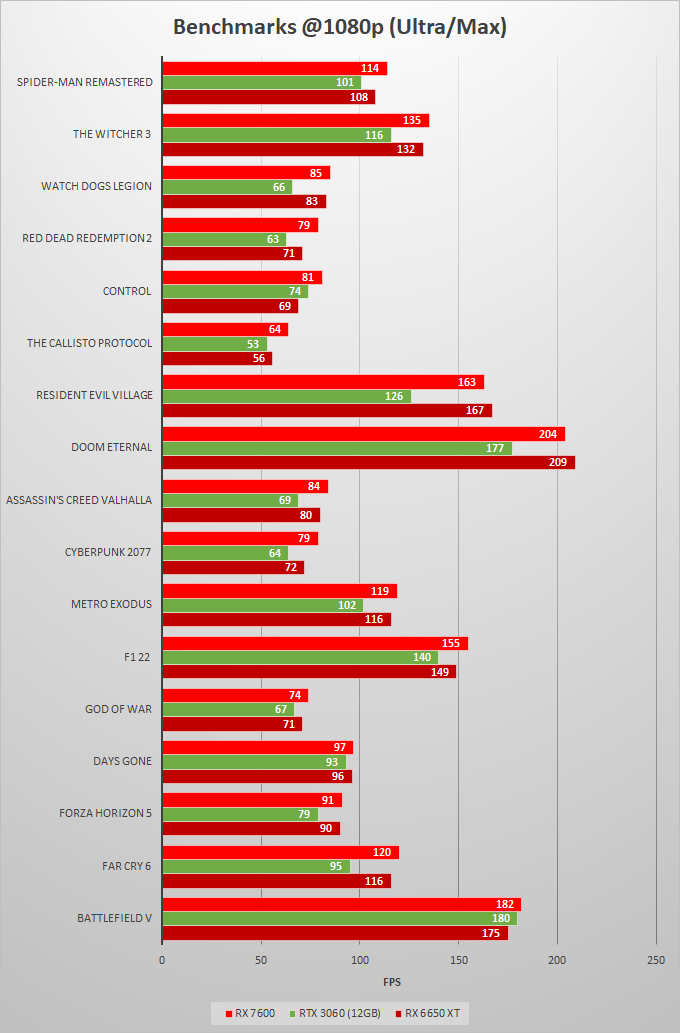
1440p Gaming Benchmarks
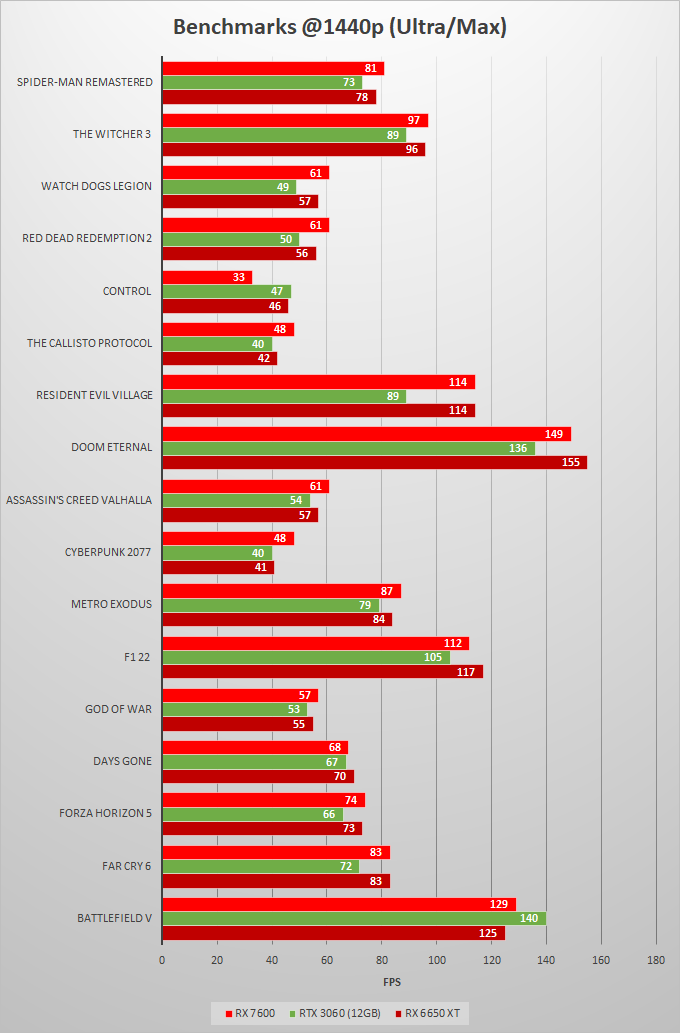
From the above benchmarks, we can see that RX 7600 is only 2 to 3 percent faster than RX 6650 XT and is around 12 percent faster than RTX 3060 (12GB).
Power Consumption
All three cards are very power efficient and the difference between them is very little. When it comes to official figures, the power consumption of RX 7600 is 165W, RTX 3060 (12GB) is 170W while that of RX 6650 XT is 180W.
| RX 7600 | RTX 3060 (12GB) | RX 6650 XT | |
| Power Consumption | 165W | 170W | 180W |
| Recommended PSU | 550W | 550W | 500W |
Pricing and Availability
When it comes to official pricing then the MSRP of RX 7600 is at 269 USD. RTX 3060 (12GB) retails at 329 USD while the MSRP of RX 6650 XT at the launch was 479 USD. There has been a steep reduction in the pricing of both RX 6650 XT and RTX 3060 (12GB) and you can find some models below 269 USD. You can check the current prices of all these cards on the links below.
Check RTX 3060 12GB Price on Amazon
Check RX 6650 XT Price on Amazon
RX 7600 vs RTX 3060 (12GB) vs RX 6650 XT Specifications
| RX 7600 | RTX 3060 (12GB) | RX 6650 XT | |
| GPU Chip | Navi 33 XL | GA106 | Navi 23 XT |
| GPU Architecture | RDNA 3 | Ampere | RDNA 2 |
| Fabrication Process | 6nm | 8nm | 7nm |
| CUDA Cores/Stream Processors | 2048 Stream Processors | 3584 CUDA Cores | 2048 Stream Processors |
| Ray Tracing Cores | 32 | 28 | 32 |
| Tensor Cores | 64 | 112 | NA |
| Memory Size | 8GB GDDR6 | 12GB GDDR6 | 8GB GDDR6 |
| Memory Interface | 128-bit | 192-bit | 128-bit |
| Memory Speed | 18 Gbps | 15 Gbps | 17.5 Gbps |
| Memory Bandwidth | 288 GB/s | 360 GB/s | 280 GB/s |
| Bus Interface | PCI Express 4.0 (x8) | PCI Express 4.0 | PCI Express 4.0 (x8) |
| DirectX | 12 Ultimate | 12 Ultimate | 12 Ultimate |
| OpenGL | 4.6 | 4.6 | 4.6 |
| Vulkan | 1.2 | 1.2 | 1.2 |
| SLI/CrossFire | No | No | No |
| VR Ready | Yes | Yes | Yes |
| G-Sync/FreeSync | Yes (FreeSync) | Yes (G-Sync) | Yes (FreeSync) |
| Power Consumption | 165W | 170W | 180W |
| Recommended PSU | 550W | 550W | 500W |
See also:
Final Thoughts
Well, RX 7600 is a pretty good card for 1080p gaming at Maximum graphics settings but the card is not that relevant now because you can get the same level of performance and power efficiency from RX 6650 XT at a lesser price. RTX 3060 (12GB) is a little slower than RX 7600 but offers 4GB extra VRAM which may come in very handy in upcoming AAA titles because the VRAM consumption of the latest games has gone very high even at 1080p resolution. The only extra features that RX 7600 offers over RX 6650 XT and RTX 3060 (12GB) are DisplayPort 2.1 and AV1 Encoding. If you want to add something here or have any queries then please do let me know in the comment section below.
(*This post may contain affiliate links, which means I may receive a small commission if you choose to purchase through the links I provide (at no extra cost to you). Thank you for supporting the work I put into this site!)
